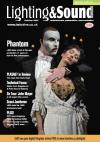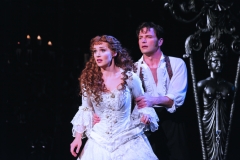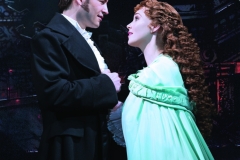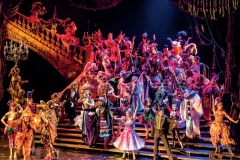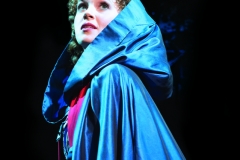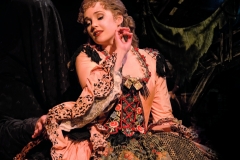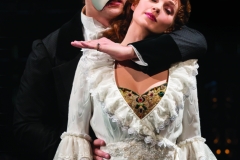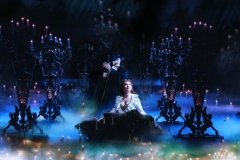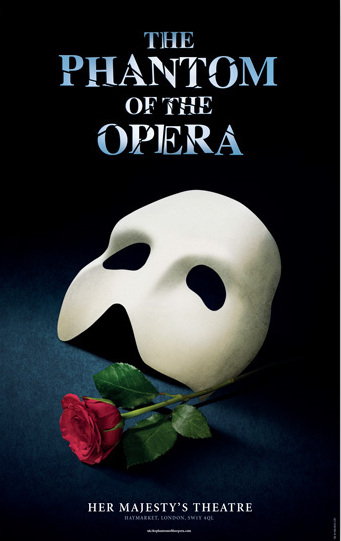
The Phantom of the Opera, London, 2021
Composer & Book: Andrew Lloyd Webber
Lyrics: Charles Hart
Book & Additional Lyrics: Richard Stilgoe
Her Majesty’s Theatre, London (2021 – )
Director: Seth Sklar-Heyn
Producer: Cameron Mackintosh
Production Design: Maria Björnson
Set Design adapted by Matt Kinley
Associate Costume Design: Jill Parker
Lighting Design: Andrew Bridge
Associate Lighting Designer: Warren Letton
Sound by Mick Potter
Musical Staging & Choreography by Gillian Lynne, recreated and adapted by Chrissie Cartwright
Orchestrations: Andrew Lloyd Webber and David Cullen [14 in the orchestra]
Musical Supervision: Simon Lee
The production resumed on 27 July 2021, with tickets on sale from 4 May 2021, booking until March 2023.
Lighting (2021)
Unlike the previous version of London’s Phantom, the new production makes extensive use of LED and moving lights, to expand the capabilities of the limited space available, while still maintaining the feel of the original. There are no flashy moving lights swinging around, but snap blackouts are now more snappy, due to the LEDs being capable of an instant blackout, with no filament fade.
Scenic: Flying (2021)
The original production (see below) had 9 fly operators. There are now 3, with a 4th going up to the fly floor for one cue.
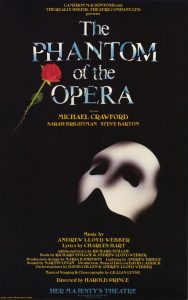
The Phantom of the Opera poster, London, 1986
Her Majesty’s Theatre, London (1986 – 2020)
Director: Harold Prince
Producer: Cameron Mackintosh
Production Design: Maria Björnson
Musical Staging & Choreography: Gillian Lynne
Lighting Design: Andrew Bridge [originally was due to be Richard Pilbrow – see the Faraday Lectures page for more]
Sound Design: Mick Potter
Original Sound Design: Martin Levan
Co-Orchestrator: David Cullen [27 in the orchestra]
Musical Supervision & Direction: David Caddick
Previews began September 27, 1986. The show officially opened on October 9, 1986.
The production celebrated its 10,000th performance at the matinée on 23 October 2010.
The run ended with the performance on 15th March 2020 when the coronavirus pandemic forced closure of UK theatres on 16th March. The ending of the run was confirmed in July 2020, and the chandelier was seen leaving the building so it can be refurbished.
The Phantom returned, but in a different version of the show.
15,000 performances passed on Saturday 8th June at 7.30pm.
Lighting equipment – Phantom London (1986)
(as of December 2016, from the Phantom Twitter LX Department takeover)
Control: Strand 520i, running two universes. There are 203 numbered cues (from 2 to 205) but there are many ‘point’ cues in between them.
Dimmers: 290 dimmers, in (vintage!) Strand STM Racks The Strand dimmers were replaced with ETC Sensor racks in 2018
Lanterns: The stock ranges from (relatively) new ETC Source 4, through to Strand Patt.23 and Patt.223 which are visible on the circle front bar. There are also Prelude Fresnels. 300 Lekos were imported from Strand in the US for the show.
There are 6 follow spots on the show – two front of house (in the traditional position) are Robert Juliat Aramis spots, and are re-lamped every 300 hours (the rated life of the lamps is 500 hours, but it would be a problem if a lamp failed during a show). There are also 4 beam lights used to subtly highlight the performers, two next to the boxes in the upper circle, and two on stage. They provide a wonderful glow.
Effects:
Smoke: The low fog machines are cooled by a twice-weekly delivery of CO2.
Intelligent Lights: There are no intelligent fixtures or moving lights in the rig (other than the chandelier and some candles!). The only DMX-controlled fixtures are strobes, smoke machines and colour scrollers. The organ, chandelier and candles are rechargeable practicals, and are charged after each show.
Flames: The flames in the stage are butane-fuelled pots from Event FX.
Pyro: Miniature detonators are used for the skull stick and the exploding candle, to ignite the flames. Le Maitre Pyroflash pots are used for the chandelier plug (silverstar) and for the star trap (theatrical flash).
The electrical props and effects were built by Howard Eaton (now Howard Eaton Lighting Ltd). As Phantom shows have sprung up around the world, advances in technology have filtered into all of the productions. LED flash effects in the chandelier were introduced for the Las Vegas shows, and are now incorporated into all of the venues. Before these, old-style camera flash bulbs were used, which had to be replaced after each show.
Staff: There are 10 LX staff on each show; 2 spots in the box, 2 spots in the auditorium, 2 spots upstage of the pros arch, 2 on-stage LX, 1 LX dayman and 1 board operator. The staff are all ‘swings’ and can swap around to do whatever task is required on each show.
Sound Equipment – Phantom London – 1986 installation
(from Lighting & Sound International, Issue 15)
“North London-based Theatre Projects have been making the news as far as major events are concerned. Their largest installation to date was for the ‘Phantom of the Opera’ at Her Majesty’s Theatre where nearly £250,000 worth of sound equipment took Derrick Zieba and his team of engineers two months to install. The project involved 108 separate loudspeakers, two 8-track tape machines, 17 radio mics, and a 54-channel computer controlled mixer. Sound design was by Martin Levan….”
Levan’s design used open drivers – Dual Concentric Drivers, out of their usual enclosures.
The show was closed for 3 days in May 2008 to allow for an upgraded system to be installed. £400,000 was spent on the upgrade which included more than six miles of cable and 120 speakers throughout the auditorium.
See The Guardian article. Meyer UPQ-1P speakers (launched in 2008) were heavily used in the new system design, by Mick Potter.
The original orchestra was 27 musicians.
When the production reopens in 2021 it will be cut down to just 16 musicians.
Scenic Automation
The ‘Masquerade’ ball staircase was built by Delstar Engineering. It is stored vertically in the flies flat-packed until it’s needed.
In New York, the control computer for the chandelier was vintage 1988, and still ran on MS DOS 3.1 (before Windows!) until the show closed.


Original Phantom of the Opera Automation Desk (1986)
Built by Barry Steel, who did similar work for many of the new musicals of the era, this console was created especially for the original production of The Phantom of the Opera, which opened at Her Majesty’s (now His Majesty’s) Theatre in London in October 1986.
From Cameron Mackintosh Ltd

 Impressario Automation Control Desk (1999)
Impressario Automation Control Desk (1999)The first Impressario desk built by AVW Controls in 1999. Later used on Phantom of the Opera in Madrid, Buenos Aires and Sao Paulo.
From Backstage Heritage Collection
Related Equipment:
Patt.23 (1953 - 1983)
520 / 520i (1997)
Pyroflash (1977)
Impressario
Dual Concentric Drivers
MAC Encore Performance WRM (2017)
Leko Range (1933 - 1998)
Documents

LSI Classic Gear - Tannoy Dual Concentric Drivers (January 2015)
[7.83Mb PDF]
From Lighting & Sound International
The Majestic Theater, Broadway, New York (1988-2023)
Previews began January 9, 1988. The show opened on January 26 1988, and will close on 16 April 2023 (originally was due to close 18 February 2023 (announced September 2022) but this was delayed due to high ticket demand).
The production marked its 24th anniversary in January 2012, and on February 11 2012 became the first Broadway musical in history to surpass 10,000 performances.
How the production came to the stage (featuring Richard Stilgoe, Cameron Mackintosh, Andrew Lloyd Webber)
Phantom of the Opera – US Tour
Phantom – The Las Vegas Spectacular
The Venetian Resort Hotel Casino, Las Vegas, Nevada
Opened 24 June 2006, closed 2 September 2012
Running time: 95 minutes
Director: Harold Prince
Choreographer: Gillian Lynne
Scenic design: David Rockwell
Chandelier Automation by Fisher Technical Services / TAIT
The show featured updated technology and effects, including a re-engineered chandelier capable of reassembling in midair during the overture while the entire interior of the venue (not merely the stage) returned to its 1880s halcyon days.
Playbill: Article about the Las Vegas Venetian production closing
Phantom of the Opera
More videos: Youtube Channel
Phantom Special Effects / Illusions
Although the exact implementation of the effects at a professional level is expensive, many of the effects from the show can be approximated with readily available equipment.
The magician Paul Daniels was involved in designing at least one of the illusions for the West End production.
- Boat
- A wheeled platform could be controlled by cables at stage level to pull it up and down stage. The top section of the boat in which the actors sit, could rotate on the platform to enable changes of direction. Or the actors could self-propel the boat around the stage, as long as there are safety guards to stop it falling off into the orchestra pit!
- Candles
- Battery-powered flicker candles are now widely available, along with more efficient LED versions, some of which are rechargeable. The battery powered ones can be wired to a switch, which could be activated by the stage lighting system. See a lighting specialist for help with this.
- Chandelier
- Whilst ‘dropping’ a chandelier should not be attempted without professional supervision, the strobe effects and ‘electrical’ sparks can be created easily. See Pyrotechnics page.
- Flames
- Stand-alone flame projectors can be hired (fed by a small replaceable gas cylinder, and triggered remotely) as can Flame Projectors that are used with the standard Le Maitre Pyroflash system.
See Pyrotechnics page.
- Stand-alone flame projectors can be hired (fed by a small replaceable gas cylinder, and triggered remotely) as can Flame Projectors that are used with the standard Le Maitre Pyroflash system.
- Phantom Chair
- The final image of the show, where the Phantom disappears from underneath a cloth covering a chair, leaves the intriguing possibility that the Phantom will return (which of course he did in Love Never Dies). This effect relies on the cloth keeping the shape of the Phantom, even if he’s not underneath it. He can then disappear through a hidden panel built into the rear of the chair. This can be accomplished with hidden wires built into the cloth. Ask a local magician if they can assist. Ensure that the effect works from all parts of the auditorium!
- Smoke
- The Phantom’s Lair sequence benefits from a covering of low-hanging fog. This helps to hide the boat mechanism and provides a great simulation of the atmosphere deep under the Opera House. This can be achieved either with dry ice or low smoke (a smoke machine through a chiller) – see Fog, Smoke and Haze page for more detail.
- Skull Stick
- See Pyrotechnics page.
Links
Keywords: phantom opera






